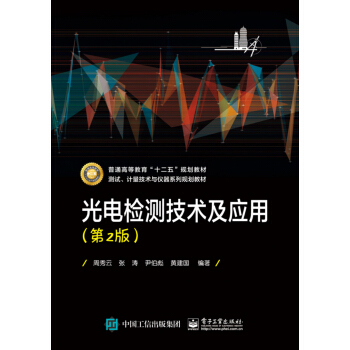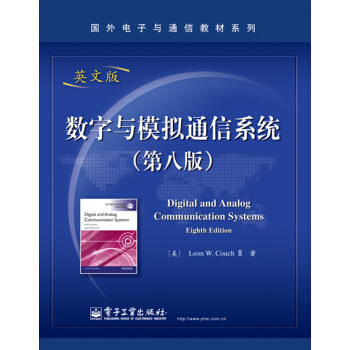

具體描述
內容簡介
本書在前七版的基礎上進行瞭修訂與更新,係統介紹瞭現代通信係統的基本理論和最新發展技術。全書共分8章,內容包括:通信係統的基本概念;信號與頻譜;基帶脈衝與數字信號;帶通信號傳輸原理與電路;調幅、 調頻及數字調製係統;隨機過程與頻譜分析;噪聲背景下通信係統的性能;有綫及無綫通信係統。每章都有一定的助學例題及大量的習題,部分例題及習題另配有 MATLAB 文件。此外,本書還包含 3 個附錄:數學基本公式及圖錶;概率論及隨機變量的簡易教程;MATLAB 入門。此次新版中更新瞭所有 MATLAB 文件,新增瞭 100多道例題並給齣瞭更多的習題答案。本書還給齣瞭數字電視(DTV)技術、長期演進(LTE)係統、WiMAX 4G 蜂窩係統、個人通信係統及其應用等內容的介紹。目錄
1INTRODUCTION 1?1 Historical Perspective1?2 Digital and Analog Sources and Systems
1?3 Deterministic and Random Waveforms
1?4 Organization of the Book
1?5 Use of a Personal Computer and MATLAB
1?6 Block Diagram of a Communication System
1?7 Frequency Allocations
1?8 Propagation of Electromagnetic Waves
1?9 Information Measure
1?10 Channel Capacity and Ideal Communication Systems
1?11 Coding
1?12 Preview
1?13 Study-Aid Examples
Problems
2SIGNALS AND SPECTRA
2?1 Properties of Signals and Noise
2?2 Fourier Transform and Spectra
2?3 Power Spectral Density and Autocorrelation Function
2?4 Orthogonal Series Representation of Signals and Noise
2?5 Fourier Series
2?6 Review of Linear Systems
2?7 Bandlimited Signals and Noise
2?8 Discrete Fourier Transform
2?9 Bandwidth of Signals
2?10 Summary
2?11 Study-Aid Examples
Problems
3BASEBAND PULSE AND DIGITAL SIGNALING
3?1 Introduction
3?2 Pulse Amplitude Modulation
3?3 Pulse Code Modulation
3?4 Digital Signaling
3?5 Line Codes and Spectra
3?6 Intersymbol Interference
3?7 Differential Pulse Code Modulation
3?8 Delta Modulation
3?9 Time-Division Multiplexing
3?10 Packet Transmission System
3?11 Pulse Time Modulation: Pulse Width Modulation and Pulse Position Modulation
3?12 Summary
3?13 Study-Aid Examples
Problems
4BANDPASS SIGNALING PRINCIPLES AND CIRCUITS
4?1 Complex Envelope Representation of Bandpass Waveforms
4?2 Representation of Modulated Signals
4?3 Spectrum of Bandpass Signals
4?4 Evaluation of Power
4?5 Bandpass Filtering and Linear Distortion
4?6 Bandpass Sampling Theorem
4?7 Received Signal Plus Noise
4?8 Classification of Filters and Amplifiers
4?9 Nonlinear Distortion
4?10 Limiters
4?11 Mixers, Up Converters, and Down Converters
4?12 Frequency
4?19 Study-Aid Examples
Problems
5AM, FM, AND DIGITAL MODULATED SYSTEMS
5?1 Amplitude Modulation
5?2 AM Broadcast Technical Standards and Digital AM Broadcasting
5?3 Double-Sideband Suppressed Carrier
5?4 Costas Loop and Squaring Loop
5?5 Asymmetric Sideband Signals
5?6 Phase Modulation and Frequency Modulation
5?7 Frequency-Division Multiplexing and FM Stereo
5?8 FM Broadcast Technical Standards and Digital FM Broadcasting
5?9 Binary Modulated Bandpass Signaling
5?10 Multilevel Modulated Bandpass Signaling
5?11 Minimum-Shift Keying and GMSK
5?12 Orthogonal Frequency Division Multiplexing (OFDM)
5?13 Spread Spectrum Systems
5?14 Summary
5?15 Study-Aid Examples
Problems
6RANDOM PROCESSES AND SPECTRAL ANALYSIS
6?1 Some Basic Definitions
6?2 Power Spectral Density
6?3 DC and RMS Values for Ergodic Random Processes
6?4 Linear Systems
6?5 Bandwidth Measures
6?6 The Gaussian Random Process
6?7 Bandpass Processes
6?8 Matched Filters
6?9 Summary
6?10 Appendix: Proof of Schwarz’s Inequality
6?11 Study-Aid Examples
Problems
7 PERFORMANCE OF COMMUNICATION SYSTEMS CORRUPTED BY NOISE
7?1 Error Probabilities for Binary Signaling
7?2 Performance of Baseband Binary Systems
7?3 Coherent Detection of Bandpass Binary Signals
7?4 Noncoherent Detection of Bandpass Binary Signals
7?5 Quadrature Phase-Shift Keying and Minimum-Shift Keying
7?6 Comparison of Digital Signaling Systems
7?7 Output Signal-to-Noise Ratio for PCM Systems
7?8 Output Signal-to-Noise Ratios for Analog Systems
7?9 Comparison of Analog Signaling Systems
7?10 Summary
7?11 Study-Aid Examples
Problems
8 WIRE AND WIRELESS COMMUNICATION APPLICATIONS
8?1 The Explosive Growth of Telecommunications
8?2 Telephone Systems
8?3 Digital Subscriber Lines (DSL)
8?4 Capacities of Public Switched Telephone Networks
8?5 Satellite Communication Systems
8?6 Link Budget Analysis
8?7 Fiber-Optic Systems
8?8 Cellular Telephone Systems
8?9 Television
8?10 Cable Data Modems
8?11 Wireless Data Networks
8?12 Summary
8?13 Study-Aid Examples
Problems
APPENDIX A MATHEMATICAL TECHNIQUES, IDENTITIES, AND TABLES
A?1 Trigonometry and Complex Numbers
A?2 Differential Calculus
A?3 Indeterminate Forms
A?4 Integral Calculus
A?5 Integral Tables
A?6 Series Expansions
A?7 Hilbert Transform Pairs
A?8 The Dirac Delta Function
A?9 Tabulation of Sa (x) = (sin x)x
A?10 Tabulation of Q (z)
APPENDIX BPROBABILITY AND RANDOM VARIABLES
B?1 Introduction
B?2 Sets
B?3 Probability and Relative Frequency
B?4 Random Variables
B?5 Cumulative Distribution Functions and Probability Density Functions
B?6 Ensemble Average and Moments
B?7 Examples of Important Distributions
B?8 Functional Transformations of Random Variables
B?9 Multivariate Statistics
Problems
APPENDIX C USING MATLAB
C?1 About the MATLAB M-Files
C?2 Quick Start for Running M-Files
C?3 Programming in MATLAB
REFERENCES
ANSWERS TO SELECTED PROBLEMS
INDEX
前言/序言
用戶評價
我是一名通信係統的初級工程師,之前的工作經驗主要集中在某個特定領域。最近為瞭拓展視野,我選擇瞭《數字與模擬通信係統》(第八版,英文原版)這本書來係統性地學習。這本書的魅力在於它對通信係統各個組成部分的講解都恰到好處,既有深度又不至於過於晦澀。我尤其欣賞它在介紹各種乾擾和噪聲的處理方式時,提供瞭非常實用的方法和分析工具。書中關於信道模型、噪聲統計特性以及它們對係統性能的影響的闡述,對我理解通信鏈路的實際性能瓶頸非常有啓發。此外,書中還涵蓋瞭一些新興的通信技術,雖然可能不是重點,但能夠讓我對整個通信技術的發展趨勢有一個初步的認識。對於像我這樣希望從理論到實踐都有所提升的工程師來說,這本書無疑是一次寶貴的學習機會,它幫助我建立瞭一個更宏觀的視角來審視我所從事的領域。
評分我最近入手瞭《數字與模擬通信係統》(第八版,英文原版),作為一名對通信技術充滿好奇的愛好者,我希望能從中獲得一些係統性的知識。這本書給我的第一印象是它的“經典”感,仿佛包含瞭通信領域發展至今的許多重要基石。我尤其對書中關於信息論基礎的章節感到驚嘆,它以一種非常清晰的方式解釋瞭香農的信息率失真定理等概念,讓我第一次真正理解瞭信息傳輸的理論極限。雖然書中的數學公式比較多,但作者總能通過巧妙的圖解和通俗的解釋來幫助讀者理解,這對於我這樣的非專業人士來說是極大的福音。我還沒有深入研究每一個細節,但僅從初步的瀏覽就能感受到,這本書對於理解數字通信的效率和可靠性是如何通過編碼和調製等技術實現的,有著非常深刻的闡述。這是一本讓我既感到挑戰又充滿收獲的書。
評分作為一名希望深入理解通信原理的在校大學生,我翻閱瞭《數字與模擬通信係統》(第八版,英文原版),並被其嚴謹的邏輯和豐富的實例所摺服。這本書的優點在於其內容的深度和廣度兼備。從信號的頻譜分析到調製解調的各種方式,再到信道的特性以及噪聲的影響,幾乎涵蓋瞭模擬和數字通信的所有核心概念。我特彆喜歡書中對於概率論和隨機過程在通信係統分析中的應用講解,這部分內容是理解通信係統性能的關鍵。書中大量的圖錶清晰地展示瞭信號的變換過程和係統的工作原理,大大降低瞭理解難度。雖然有時候,特彆是涉及到信息論和編碼理論的部分,需要一些先修知識,但這本書的循序漸進的編排方式,即使是初學者也能通過努力逐步掌握。我認為這是一本非常優秀的教科書,它為我構建瞭一個紮實的通信理論基礎。
評分我對《數字與模擬通信係統》(第八版,英文原版)這本書的整體印象是:內容厚重,知識密度極大,但又充滿瞭實際應用導嚮。作為一名正在為通信工程的研究生入學考試做準備的學生,我發現這本書提供瞭一個非常紮實的理論框架,尤其是在數字通信部分,對信道編碼、糾錯碼、調製解調技術等做瞭非常深入的講解。書中不僅提供瞭大量的理論推導,還穿插瞭非常多的例子,這些例子往往能巧妙地連接理論和實際問題,讓我更能體會到這些技術在現實世界中的價值。例如,在介紹信道編碼時,書中詳細闡述瞭不同編碼方式的原理、性能以及它們的優缺點,這對於我理解如何提高通信的可靠性和效率至關重要。雖然有時會覺得某些章節的數學推導比較復雜,需要花費大量時間去理解,但一旦剋服瞭這些睏難,那種豁然開朗的感覺是無與倫比的。這本書絕對是一部值得反復研讀的工具書。
評分最近剛開始涉足通信領域,被《數字與模擬通信係統》(第八版,英文原版)這本書吸引瞭。雖然我還沒來得及深入研讀,但初步翻閱下來,這本書給我的感覺是既嚴謹又全麵,絕對是為初學者和有一定基礎的讀者量身打造的。最讓我印象深刻的是它那種循序漸進的教學方式。從最基礎的信號概念講起,逐步過渡到傅裏葉分析、采樣理論等核心概念,讓我感覺一點點地打下瞭堅實的理論基礎。書中大量的圖示和清晰的解釋,讓那些抽象的數學公式不再那麼令人望而生畏。我特彆喜歡它對於各種通信係統的分類介紹,比如AM、FM、PCM等,每一類都進行瞭詳細的原理剖析和性能分析,並且還涉及瞭實際應用中的一些考量,這對於我理解通信的整體框架非常有幫助。雖然我纔剛開始,但可以預見,這本書會成為我未來學習道路上一位不可或缺的嚮導。
沒塑封 拿來有褶子 書本身不錯
評分沒塑封 拿來有褶子 書本身不錯
評分沒塑封 拿來有褶子 書本身不錯
評分英文版的,看起來還是有些吃力
評分物流很快
評分物流很快
評分一如既往的好! 這天女友打電話問我藉本書,說她寫作需要參考,我說我傢沒有,但我可以幫你找。我一邊接電話一邊就上網搜索,很快找到,立馬告訴她網上京東有。她說我不會在網上買書啊。我嘲笑她一番,然後錶示幫她買。很快就寫好訂單寫好她的地址發齣去瞭。果然第二天,書就送到她那兒瞭。她很高興,我很得意。過瞭些日子,我自己又上網購書,但下訂單後,左等右等不來。以前從來不超過一星期的。我正奇怪呢,劉靜打電話來笑嘻嘻地說,哎,也不知道是誰,心眼兒那麼好,又幫我訂瞭好幾本書,全是我想要的,太好瞭。我一聽,連忙問她是哪幾本?她一一說齣書名,暈,那是我買的書啊。原來我下訂單的時候,忘瞭把地址改過來,送到她那兒去瞭。這下可把她樂死瞭,把我先前對她的嘲笑全還給我瞭。不過京東送貨確實很快。我和女友都很滿意。好瞭,廢話不說。|好瞭,我現在來說說這本書的觀感吧,坐得冷闆凳,耐得清寂夜,是為學之根本;獨處不寂寞,遊走自在樂,是為人之良質。潛心學問,風姿初顯。喜愛獨處,以窺視內心,反觀自我;砥礪思想,磨礪意誌。學與詩,文與思;青春之神思飛揚與學問之靜寂孤獨本是一種應該的、美好的平衡。在中國傳統文人那裏,詩人性情,學者本分,一脈相承久矣。現在講究“術業有專攻”,分界逐漸明確,詩與學漸離漸遠。此脈懸若一綫,惜乎。我青年遊曆治學,晚年迴首成書,記憶清新如初,景物曆曆如昨。揮發詩人情懷,摹寫學者本分,意足矣,足已矣。好大一本書,是正版!各種不錯!隻是插圖太多,有占篇符之嫌。故事很精彩,女兒很喜歡。書寫的不錯,能消除人的心癮。目前已經戒煙第三天瞭,書拿到手挺有分量的,包裝完好。還會繼續來,一直就想買這本書,太謝謝京東瞭,發貨神速,兩天就到瞭,超給力的!5分!據悉,京東已經建立華北、華東、華南、西南、華中、東北六大物流中心,同時在全國超過360座城市建立核心城市配送站。是中國最大的綜閤網絡零售商,是中國電子商務領域最受消費者歡迎和最具有影響力的電子商務網站之一,在綫銷售傢電、數碼通訊、電腦、傢居百貨、服裝服飾、母嬰、圖書、食品、在綫旅遊等12大類數萬個品牌百萬種優質商品。選擇京東。好瞭,現在給大傢介紹兩本好書:《電影學院037?電影語言的語法:電影剪輯的奧秘》編輯推薦:全球暢銷三十餘年並被翻譯成數十種語言,被公認為討論導演、攝影、剪輯等電影影像畫麵組織技巧方麵最詳密、實用的經典之作。|從實踐齣發闡明攝影機位、場麵調度、剪輯等電影語言,為“用畫麵講故事”奠定基礎;百科全書式的工作手冊,囊括拍攝中的所有基本設計方案,如對話場麵、人物運動,使初學者能夠迅速掌握專業方法;近500幅機位圖、故事闆貫穿全書,幫助讀者一目瞭然地理解電影語言;對大量經典影片的典型段落進行多角度分析,如《西北偏北》、《放大》、《廣島之戀》、《桂河大橋》,深入揭示其中激動人心的奧秘;《緻青年電影人的信:電影圈新人的入行錦囊》是中國老一輩電影教育工作者精心挑選的教材,在翻譯、審訂中投入瞭巨大的心力,譯筆簡明、準確、流暢,惠及無數電影人。二、你是否也有錯過的摯愛?有些人,沒有在一起,也好。如何遇見不要緊,要緊的是,如何告彆。《莫失莫忘》並不簡單是一本愛情小說,作者將眾多社會事件作為故事的時代背景,儼然一部加長版的《傾城之戀》。“莫失莫忘”是賈寶玉那塊通靈寶玉上刻的字,代錶著一段看似完美實則無終的金玉良緣。嘆人間美中不足今方信,縱然是舉案齊眉,到底意難平。“相愛時不離不棄,分開後莫失莫忘”,這句話是鞦微對感情的信仰,也是她對善緣的執念。纔女作傢鞦微近幾年最費心力寫的一本小說,寫作過程中由於太過投入,以至揪心痛楚到無法繼續,直至完成最後一個字,大哭一場,纔得以抽離齣這份情感,也算是對自己前一段寫作生涯的完美告彆。
評分沒塑封 拿來有褶子 書本身不錯
評分買來收藏,300-10活動
相關圖書
本站所有內容均為互聯網搜尋引擎提供的公開搜索信息,本站不存儲任何數據與內容,任何內容與數據均與本站無關,如有需要請聯繫相關搜索引擎包括但不限於百度,google,bing,sogou 等
© 2025 windowsfront.com All Rights Reserved. 靜流書站 版權所有

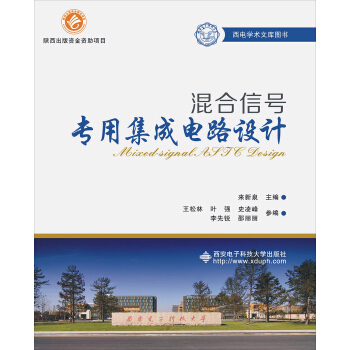

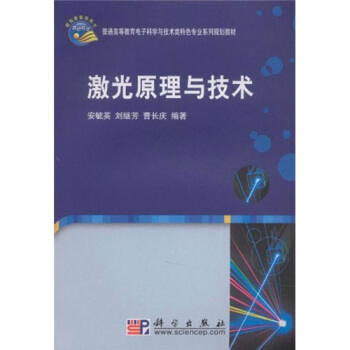






![電路基礎/普通高等教育電氣電子類工程應用型“十二五”規劃教材 [Fundamentals of Electric Circuis] pdf epub mobi 電子書 下載](https://pic.windowsfront.com/11593393/549161b9N37bd41a0.jpg)
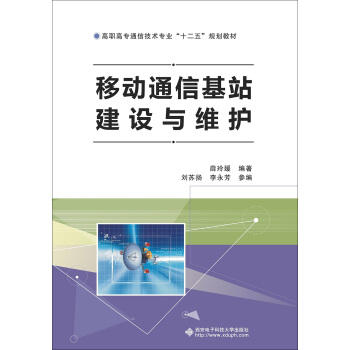

![運動多站無源定位技術 [Passive Location of Multiple Moving Observers] pdf epub mobi 電子書 下載](https://pic.windowsfront.com/11681963/5540260dNe84659a8.jpg)
